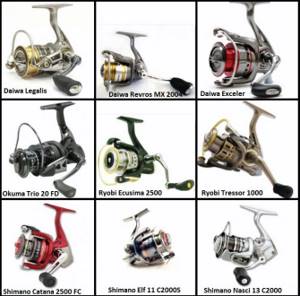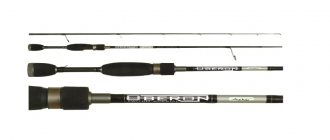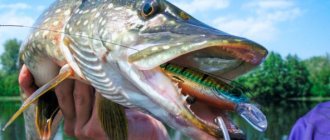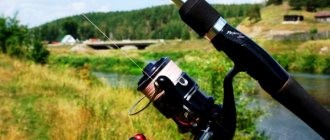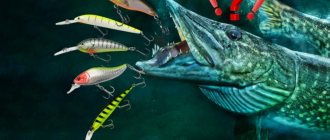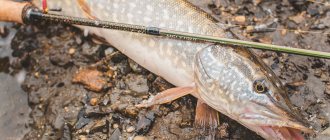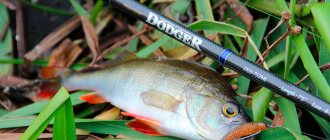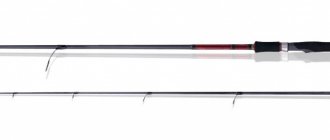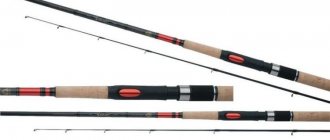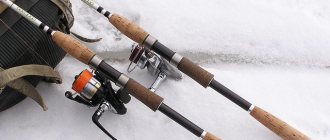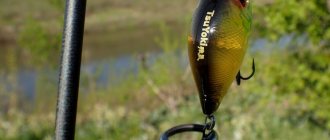Microjigging involves the use of light and sensitive rods, and therefore, to maintain balance, the reel must be appropriate.
In this article we will talk about the features that a microjigging reel should have. We will focus on such parameters as the size and weight of the reel, friction brake, presence/absence of an instant stopper, line laying, backlash, smoothness.
At the end of the article, we created a ranking of the nine best budget reels in the $30 to $100 price range.
Which reel to use for microjigging
So, first, let’s look at the weight and size of the reel for microjig fishing.
It is not at all necessary to look for the lightest and most compact reel, because the main guideline when selecting a specific model is still maintaining the balance of the entire tackle.
In other words, when choosing a reel, consider the weight and length of the rod itself. It is important that after installing it on the rod, the center of gravity falls approximately at the place where the reel is fixed.
We advise you to buy a reel along with the spinning rod itself to get an excellent balance of gear!!!
The best models and manufacturers of spinning rods for microjigging
Choosing a good model is not difficult.
When choosing, you need to take into account certain parameters and characteristics. Let's take a closer look. A test is a certain range of weights that a spinning rod can handle. If you choose the right test, the fisherman will feel the bite and feel comfortable casting the tackle. As a rule, this characteristic is indicated on the form.
For fishing with this type, the following weight range is used: from 1 to 8 grams. When choosing a test, you need to take into account the characteristics of the baits used. The maximum acceptable test is 12 grams.
What should be the test range:
- 2–12 grams;
- 2–10 grams;
- 1–10 grams;
- 1–7 grams;
- 0.5–5 grams;
- 0–5 grams.
Test Range Classification:
- universal (1–8 grams);
- for work in the upper segment (4–12 grams);
- for work in the lower segment (1–4 grams).
When choosing a product, you must take into account the fishing line test.
What should be the assembled length?
It all depends on the place and fishing conditions:
- Products with a length of 2.4–3 m are rarely used.
- Universal models have a length of 2.1–2.4 m. Such models can be used for fishing from a boat or shore.
- Rods 1.8–2 m long are used in small bodies of water. And they are also effective in cramped conditions.
Action is a characteristic of the mechanical rigidity of the whip.
The structure is classified into several categories:
- extrafast. Thus, models that practically do not bend are designated.
- fast. Thus, products are designated for which only the tip works.
- medium. Only the top half bends.
- slow. Bends the entire length.
As a rule, for microjig, a fast action with a glued tip is chosen.
Other features of the system:
- the top should be soft;
- The form must be rigid.
Some fishermen use softer spinning rods (medium action). In this case, the fisherman can control the wiring visually. But still, the majority use fast action rods.
How much should a fishing rod weigh? It is recommended to use lightweight models (80–120 grams). Because all other parts of the tackle (reel, line, etc.) are very light.
Let's look at the most popular models and manufacturing companies.
Graphiteleader
Graphiteleader was founded in 2004.
Graphiteleader Products:
- fishing rods;
- bait;
- other “products” for fishing.
The company recently entered the Russian market. But during this time, Graphiteleader managed to become a recognizable brand. Consider the Graphiteleader Calzante EX GOCAXS model. This is a popular model in the mid-budget category.
Advantages:
- light weight;
- high strength;
- graphite is used for manufacturing.
The company was founded in 2007. Aiko offers its customers high-quality gear at an affordable price. There are real masterpieces in the lineup.
Consider the AikoTirrel 215 ULS model
Spinning is ideal for catching predatory fish.
Characteristics:
- medium-fast action;
- good sensitivity
- equipped with modern rings.
Shimano
Shimano is a world famous company. It was founded in 1921. Shimano occupies a leading position in fishing equipment.
Consider the Shimano Soare Ci 4 S706 ULT model.
This is a very light rod. It is equipped with titanium rings.
Characteristics:
- weight 84 g;
- line test 2–6 lb;
- length 2.21 m.
Mikado
Mikado is a world famous manufacturer of fishing equipment. Mikado was founded in 1989.
Consider the Mikado Almaz Bolognese 500 model. This is a wonderful fishing rod that is made of carbon and carbon fiber. Has a non-standard length.
Friction brake
A microjigging reel must have a front friction brake.
The front clutch is more sensitive and reliable than the rear, which is extremely important when catching small fish with ultra-light baits!!!

The friction should be smooth, that is, it should release the line evenly under load, and not jerkily.
Quite large fish can often bite on micro-baits, and in order to get such a catch, and not tattered gear, you need to take care of carefully adjusting the front drag. Otherwise, just one strong jerk from a large fish will be enough for you to lose your favorite bait.
What should you pay attention to?
Before choosing a reel, you need to pay attention to its main performance characteristics and parameters in order to draw a conclusion about its suitability for full-fledged microjig fishing:
- size;
- weight;
- type of friction brake, its quality;
- spool characteristics;
- line winding quality;
- ease of movement, presence of play;
- reverse stopper.
The optimal reels for microjigging are models in sizes 1000–2000. There is no point in taking larger ones, and there is no point in making them smaller. Weight approximately 200–230 grams. Models that are heavier will upset the balance, making it difficult to perform high-quality wiring with jerking elements. The fisherman will get tired, the sensitivity of the gear will be impaired, etc.
The friction mechanism can be located at the front or rear. Preference should be given to the front clutch. Models with this brake arrangement are more compact and have less weight. The finer the tuning of the mechanism, the better. It should be triggered by sudden jerks of the fish, preventing the line from breaking.
Thin cords require a low profile spool. It eliminates the need to reel in several hundred meters of backing, facilitates long-distance casting of the lightest baits, and reduces the likelihood of the fishing line getting tangled. Many manufacturers have in their assortment modifications with a small spool.
A good reel for microjigging must lay the thread evenly on the spool. Any humps, dips, or cutting of turns into each other lead to spontaneous release of loops, twisting of the line, and the formation of beards. As a result, you have to cut off several tens of meters of expensive cord or completely throw away the entire reel, having to buy a new one.
Smooth and quiet running is an integral parameter of a good spinning reel. Extraneous noises and rustles will interfere with concentrating on fishing and controlling the wiring of the “rubber”. The presence of a reverse stop is not discussed - it is definitely needed.
Coil material
It is natural that the weight of any reel depends on the materials that were used in its production. So, the more metal elements in the model, the more its weight will be, but the reliability also increases.
Most modern microjigging reels have an aluminum spool, but the bodies can be made of plastic or metal.
However, such recognized companies as Shimano or Daiwa produce high-quality reel models of any size, made of lightweight but very durable composite materials. Although the cost of such elite reels is appropriate.
The plastic case is bad because under load it deforms more, which creates additional stress on the reel gears. Aluminum cases are more rigid and reliable.
Primary requirements
The success of fishing depends on the correct selection of equipment. When buying a spinning rod you need to consider:
- Rod weight;
- Line test;
- Top type.
For microjigging, rods with a length of 1.8 to 2.1 meters are suitable. The lure test depends on the type of sinkers and jig heads.
https://www.youtube.com/watch?v=88NLAp8Pk_0
When purchasing fishing equipment for microjigging, choose a fast action. The glued tip will increase the sensitivity of the spinning rod. It will transmit the slightest vibrations of the rod.
To reduce the weight of the spinning rod, you need to use light reels and thin cords. The average weight of the equipment does not exceed 130 grams. If you have the financial means, you can purchase elite fishing rods. Their weight is 100 grams.
Attention! When choosing a cord, pay attention to the maximum load. If this value is exceeded, the spinning rod may break.
Don't skimp on pass rings. They should not only be light, but also strong enough. For microjigging, small-diameter pass rings are used. Without thin cords it is impossible to cast long distances.
Thanks to the rings, you can distribute the load over the form. This will increase the strength of the rod. However, an increase in the number of rings affects the casting distance. This is due to increased friction of the fishing line that comes into contact with the rings.
Handles for spinning rods can be solid or spaced. Experienced fishermen prefer fishing equipment with a solid handle. This is due to greater sensitivity and less weight.
It is necessary to take into account the miniature size of baits that are used when fishing. To reduce line wear, you need to reduce friction on the rings. Even a slight indentation can wear out the thin cord. To do this, the manufacturer polishes the rings.
When choosing a spinning rod, be sure to consider the structure. The response of the rod to the load depends on this characteristic. The fast action ensures that only the tip of the rod bends under load.
Beginners should purchase 2 models with different characteristics at once.
First you need to learn how to fish from the shore. To achieve good results in such conditions, you need to give preference to rods with a fast action.
The length of the spinning rod should be about 2.5 meters. Make sure that the top is painted in a bright color. It will be easier for a novice fisherman to control the bait.
Another rod will be designed for fishing from a boat. A long rod is not suitable for such conditions. It is best to choose models with a length of about 2.1 meters. The build must be fast. The test can be taken about 8 grams. Different models of spinning rods will help a beginner to feel the bait better.
The characteristics of the minimum test of the blank declared by the manufacturer do not guarantee that the tip will react the moment the bait touches the surface of the bottom of the reservoir. The lower limit is often lowered to improve the performance of the spinning rod.
Stiff and fast rod
Have you decided to take up microjig fishing? In this case, you need to choose a spinning rod with a glued tip. With a rigid and fast blank you can ensure complete control over the bait.
The glued tip is highly sensitive. For an experienced fisherman, it will not be difficult to determine the moment when the bait touched the bottom of the reservoir or when the fish became active.
The disadvantage of this rod is the lack of versatility. The flexible tip is not suitable for fishing with spinners or wobblers.
Fast spinning action
Rods with a hard tip are considered universal in the ultralight category. They allow the fisherman to use baits that weigh 1.5-2 grams. The advantage of fishing equipment of this class is that during fishing you can use wobblers and spinners.
Medium action spinning rod
For microjigging, you can use a medium action spinning rod. To be successful, fishermen use brightly colored monofilament rather than line. Control of the wiring is carried out along the fishing line, and not along the top of the spinning rod. Rich tones make it easier to spot bites.
The elastic material of the rod dampens the jerks of aggressive fish. However, such equipment cannot be used in windy weather.
What does the type of tips affect?
On sale you can find models with 2 types of tips:
- Rods with a hollow tip are designated by the letter "T". They are more rigid and suitable for using loads from 4 grams.
- Solid paste (S) works better with small weights. Fishermen appreciate such models for their precise movements.
Advice. To make it easier to observe the bite along the tip, paint is applied to the tip of the spinning rod. Some anglers paint the tip edge themselves. In this way they want to make it more visible.
Mid-priced models
Before we start choosing gear, we need to figure out why we will choose it. After all, this will allow us to immediately discard a lot of unnecessary spinning rods, reels, etc. Therefore, I propose to first understand what microjig is.
Speaking in general terms, microjig is the same jig fishing, only using small weight sinkers with medium-sized baits. But this smallest weight is different for everyone. Some say that microjig starts from 10 grams and below, while others believe that the upper limit for this fishing method is a load of 3 grams.
Personally, my opinion is the following. By microjig I mean a jig lolvue where a sinker weight of 1 to 5 grams is used using baits, roughly speaking, up to 2.8 inches inclusive.
Based on this formulation of the concept of “microjig,” we will approach the selection of the necessary gear, as well as other nuances of such fishing. After all, an ultra-light jig differs from its older brother not only in the weight of the bait. There are a number of other serious differences. But first things first. Let's start with the microjigging rig.
The selection of gear for catching perch with a microjig, like the selection of any gear, should be approached with great responsibility. After all, the comfort of our fishing trips, their effectiveness, as well as the degree of satisfaction from this activity will depend on what we choose.
Therefore, I decided to describe all the points that a beginner should pay attention to when choosing his first gear for microjig fishing. We will choose in the following sequence:
- Spinning;
- Coil;
- Cord or fishing line;
- Consumables.
Spinning rod for microjig fishing
The main tool in spinning fishing is the rod. The result of our fishing trips will depend on which option we choose. And we need to choose a spinning rod that will allow us to perform a maximum of retrieves, will inform us well about contact with the bottom, obstacles and fish, and will also fight well with large ones and keep small trophies on the hook.
I already mentioned above that microjig for me is jig fishing with a load of up to 5 grams plus bait. In total, our top weight is about 7 grams. This is worth considering when choosing a spinning rod. He must work with such weights, if not ideally, which is very welcome, then as comfortably as possible. So which spinning rod to choose for microjigging?
And here's what you need to know: Do-it-yourself rubber band for fishing
For a beginner, I would immediately recommend Rock fish class sticks. It is highly desirable that they be representatives of the Japanese market. It just so happened that it was Japanese manufacturers who succeeded in producing such instruments better than others. Yes, prices for spinning rods from Japan will be slightly higher than products from China, Korea, etc. But the quality of the product will be much higher.
I remember when I was choosing my first spinning rod for microjig, I had very little information. Today I think that it was possible to save a lot of money by buying a decent apparatus right away, and not going through the process of getting a good spinning rod through fishing with all sorts of cheap sticks.
I would personally advise beginners to pay attention to the following models: Major Craft Solpara, Major Craft Zaltz, Major Craft Skyroad, Major Craft AIRock, Graphiteleader Calzante, Graphiteleader Finezza. In my opinion, they are perfect for mastering perch fishing with a microjig and will delight you for many years if treated with care. And these models are definitely worth the money.
Well, in general terms of choosing a spinning rod for microjig, I would like to dwell on the key points. It is necessary to distinguish that the bulk of such spinning rods are divided into two classes.
The first is spinning rods with an insert, which is a solid whip glued into the upper end of the spinning rod. This spinning rod is designated as solid.
In principle, today there are many types of such glued-in tops, but this point should be considered separately, and for a beginner, general information on glue-ins will be enough at first. Another option is tubular.
This means that the spinning rod does not have glued elements and ends with a hollow tip, which is integral with the upper bend. These two types of spinning rods have both pros and cons in their operation.
[adsense]
Solid spinning rods are perfect for those who fish in the lower test range of spinning rods. This type of tip allows you to work well with light weights.
Another advantage of this type of spinning rod is its work on fishing. I'm saying that the feeling of fighting fish when using a spinning rod with an insert is much brighter than with a tubular one.
But there are also disadvantages to this spinning rod. Firstly, it has been repeatedly noticed that the insert drains very small fish.
If on simple fishing trips this is not entirely important, then in cases where the result is critically important, this moment can play a cruel joke. Secondly, spinning rods with a glued tip do not work well in the upper test range.
They will simply collapse under the weight of the load and/or the emphasis of the bulky bait and will not allow such equipment to be carried out efficiently. The same story applies to wobblers and spinners, which have quite a lot of resistance.
High-quality wiring cannot be achieved. Although such baits are not profiling, their use is sometimes very appropriate.
Tubular spinning rods allow you to work in the upper test, but behave worse in the lower range. At the same time, as for me, this type of spinning rod has a higher sensitivity, because they do not have an extra transition between the insert and the body of the spinning rod, which slightly neutralizes the feeling of contact with the bait.
Although, this is all quite figurative. Tubular is more versatile in terms of baits, which allows you to use small wobblers and spinners with it, if necessary.
Well, he doesn’t waste small things that much.
Personally, my opinion regarding the choice of the type of spinning rod for a beginner is inclined to choose the Tubular type. It is more versatile and forgiving of mistakes. But a delicate insert may not open up for a person who has picked up a microjig spinning rod for the first time, and will leave not the best impressions. Although everything here is also very figurative.
So, when choosing, we take into account the range of weights that we will use on most fishing trips, and, based on this, we select a spinning rod with the desired test and type of tip. As for the test, almost all Rock Fish spinning rods for working with small weights have a test of 0.5-5 grams or 0.5-6(7.8) grams.
It should be mentioned that microjig can use spinning rods not only of this class, but also many others. But I would recommend Rock Fish to beginner microjigists, so that they can quickly understand what kind of fishing it is.
Micro jig reel
When choosing a reel for microjigging, everything is much simpler. There are several points to pay attention to here, which we will talk about.
Firstly, the reel must be in harmony with the spinning rod and create a good balance with it. Therefore, heavy reels are not very welcome in microjig fishing. But, at the same time, you should not immediately go to the lightest models. According to my observations, the ideal reel weight in most cases will be in the range of 180-220 grams. There are many suitable models in this reel weight range.
First of all, pay attention to reels from DAIWA and Shimano. They are today the flagships in the production of the reels that interest us.
As for the standard size, everything is more or less clear here too. We select reels of size 2000-2500 according to Shimano and 2003-2506 according to DAIWA.
In my opinion, these are the most interesting sizes for microjigs. With a larger reel we will gain in reliability and casting range.
But finding such a low-cost model in the required weight is quite difficult, which cannot be said about the 2000 size. In the more budget segment, I think Shimano reels are the leaders, but from 2500 I still advise you to pay attention to Daiwa.
Please note that a good reel cannot cost little. And it’s better to buy a quality product right away than to later pay for constant tuning or maintenance of a budget model.
Therefore, when choosing, do not spare money and look towards models from 130-140 dollars. In principle, for a beginner I would advise you to look at the Shimano Ultegra c2000S reel, which is the basis for more expensive models.
If finances allow, then you can look towards Daiwa Luvias 2506 and higher. At the same time, we still give priority to the larger standard size.
What do we wind on the reel when catching perch with a microjig?
The answer to this question is obvious. For a beginner, I would definitely recommend a braided cord. It has its advantages over other options. The braid has zero or almost zero elongation. Due to this, the sensitivity of the tackle increases significantly. And this is very important in catching perch with a microjig, where you need to monitor any contact of the bait.
Compared to monofilament fishing line, braided cord with a smaller diameter has a higher tensile strength. Accordingly, with thin material that will fly much further, it will be possible to remove even large fish without any problems.
And here's what you need to know: Fishing with a spinning rod using a jig. Justified minimalism
One point that I consider mandatory in microjig fishing is the use of a fluorocarbon leash. This is an axiom for me today.
An exception to the rule may be catching perch with a microjig in winter. At this time, there is every chance that the cord will freeze in the air, because it absorbs water. Here it is still better to use monofilament fishing line. Yes, today there are all kinds of silicone sprays for the cord that prevent freezing, but I do not recommend using them, so as not to kill the cord or, even worse, the reel.
We must also remember about a product such as Nanofil. I'm sure that newbies looking for information about microjigging on the Internet have come across articles about this option for winding on a reel.
Yes, Nanofil helps to throw the bait over the horizon, but still I would not recommend it for beginners. It's easy to ruin your microjig experience.
First, it’s better to practice with the cord, and only then think that it’s better to wind it on a reel.
What diameter of cord for microjigging should I choose? I think for starters you shouldn’t select the thinnest cords. Better practice with #0.
4 or even #0. 6 according to the Japanese classification, and only then move on to #0.
thirty. 2 and even thinner.
Among the manufacturing companies, I would advise you to pay attention to the Japanese, namely: Sunline, Varivas, YGK, Duel, Unitika. From the cords of these brands, you can choose a product that is suitable for the price of almost any angler.
And they are all of good quality.
Consumables for microjig
The issue of choosing consumables for microjig should be approached just as responsibly as choosing a spinning rod or reel. After all, it depends on what kind of sinkers, hooks, etc. we choose, the result of the fishing as a whole will depend. I will not dwell on each position for a long time; I will just write models that, of course, are leaders in their field of application today.
I advise a beginner to use lead sinkers. By and large, it makes no difference where you buy them.
But I advise you to fish with “Cheburashka” type weights. Hinged mounting has a number of advantages and is considered more universal.
Therefore, leave classic jig heads aside. Please ensure that the wire in the sinker holds well, is made of stainless wire, and the hook can move freely along the eye of the Cheburashka.
As for the hooks, select their size so that the throat is not smaller than the diameter of the sinker. Otherwise, you may be haunted by incomprehensible gatherings. As for models, hooks of models S-59 and MH-12 from the manufacturer Owner have long become classics. The Decoy company also has cool series for catching perch with microjigs. I consider these two manufacturers to be the best in this area.
I also classify fluorocarbon as consumables. And I don’t advise a beginner to put too much effort into choosing it.
Yes, there is plenty of this material on the market. But there is no point in paying attention to expensive models right away.
In general, for starters, you can easily get by with a good fluorocarbon-coated fishing line. For a budget option, you can pay attention to Basic FC from Sunline.
Personally, today I use Climax fluorocarbon, which does not cost much compared to other models, but also suits me 100%.
What about baits? In principle, this is also a separate topic that should be considered in a separate article. A lot can be learned from my “Silicone Lures” section, where I describe different companies and models. In a few words, a beginner should have a twister, a vibrotail and a worm or leech. Such forms are quite enough for starting in microjig.
So I finished the first part of the story about microjig, where we studied how to choose gear for microjigging. I hope newbies will find answers to their questions here. And if something is not clear, or you have additional questions, please ask them in the comments. In the future, I will continue a series of articles on microjigging for beginners.
In Japan, there is a type of fishing called rockfish, or more precisely, mebaring - this is catching small fish from the shore or pier at sea. Mebaru rods have solid or tabular tips. The first ones are, for the most part, extra fast, the second ones are fast.
If everything is clear with the tabular - this is a regular tip like all other spinning rods, then the solid is glued in to increase any of the parameters responsible for controlling the wiring. For example, a glued tip can be much softer than a tip made of the same material as the blank itself.
This allows you to increase visual control over the bait (it will be easier to see the return of the tip when biting or falling to the bottom).
The tip can also be short and stiffer, which will give more opportunities to play along with the rod when retrieving (more on this a little later). It is a rod with a solid tip that is best suited as the first microjigging spinning rod. Tabular is more universal and is suitable for almost all types of ultralight fishing, but everything universal is the enemy of the special.
Another serious requirement for a microjigging rod is sensitivity. If the spinning rod does not have acceptable sensitivity, then fishing will be difficult and even uninteresting. It’s nice to feel with your hand how a load weighing one and a half grams falls on the pebbles at the bottom, or to feel any snags or fish touches - that’s where the whole thrill of fishing with a microjig lies.
Microjig fishing involves the use of monofilament lines and small diameter cords. Because of this, special requirements are placed on reels for ultra-light jigs:
- Smooth laying of the fishing line on the spool without the formation of humps and dips, which can lead to the loss of loops and the formation of beards. Thin fishing lines are expensive and their premature damage leads to unreasonable expenses;
- The ability to cast ultra-light baits over decent distances. For microjig this is about 35–50 meters;
- Smooth, silent movement, allowing you to perform various animation techniques, while feeling all the movements of the bait under water;
- Fine-tuning of the friction brake and its high sensitivity in order to avoid line breakage due to a sudden bite or sharp hooking.
The best microjigging reel should meet these requirements. An important parameter is its weight. You need to select a model that will perfectly balance with the fishing rod.
Advice! A very light reel is not always good. Having upset the balance, the rod will begin to “peck” at the tip, which also tires the angler’s hand, as does too heavy tackle.
And here's what you need to know: The best budget spinning rods for twitching large wobblers 110-130
A multiplier reel is not used for microjigging. Today, some companies are just beginning to produce cartoons for light spinning rods and weightless baits. However, it is not in demand among domestic fishermen due to its high price, unavailability at fishing points, lack of detailed information and detailed responses. Read more about multipliers here.
Spinning rods with a length of 1.5 to 2.7 meters with a test range of up to 5 - 6 g are used as microjig rods. As a rule, these lightweight carbon fiber rods have a fast and medium-fast action.
From the point of view of manufacturing technology and design, fishing rods can be made of one material and with a glued fiberglass tip. The latter are highly specialized fishing rods, “tailored” for MJ.
Another distinctive feature of a spinning rod for microjig is the presence of a spaced handle, which has a positive effect on the weight of the rod and its ergonomics.
The main characteristic when choosing a spinning rod for microjigging is its sensitivity. For an angler using this spinning rod, the following components must be provided: control over artificial bait, bite indication, low weight of the rod, the necessary strength and reliability.
In microjig, either braided fishing line (braid, cord) with a diameter of no more than 0.08 mm, or ordinary monofilament fishing line of bright colors with a diameter of up to 0.14 mm is used.
In my opinion, it is preferable to use braid because of its minimal stretch. This important property makes it possible to better control the bait when retrieving and biting fish. At the same time, it will not be possible to achieve this possibility when using monofilament fishing line due to its elongation of up to 20% of the initial length.
For the last couple of years, I have been using Super PE cord (6lb diameter, 3kg breaking load) from Sunline as my microjigging line. If we talk about color, I consider white braided fabric to be optimal because of its visibility.
A rod for microjigging must have a good action in order to perfectly feel the light bait and make a high-quality hook. Soft sticks have no place in this method, because... the ending will constantly dampen hand movements.
Also, fast action is needed for sufficient sensitivity when wiring. The microjig method does not catch the largest fish, so each movement must be effective and should not be repeated immediately.
Hooking should be done easily, naturally - with a slight poke if necessary.
The most popular rods are the Japanese brand “Rock Fish” - with an ideal price-quality ratio. In general, the length of the spinning rod should not exceed 2.5 m. It is enough for fishing in the bushes and for long casts. High action is achieved by a removable top, which takes responsibility for the quality of such fishing. There are two types of vertices:
- Tubular. Thick and hollow inside. It has increased rigidity, which ensures good sensitive contact with the hand. This type of ending eliminates its breakdown, because perfectly dampens any jerks of the fish. Thanks to this, fishing with it is very convenient and safe;
- Solid. Thin and extremely sensitive tip. Excellent for bottom exploration, because... you can feel all its irregularities. It works noticeably worse in the upper layers. You need to fish it out carefully, without sudden jerks, so as not to break it.
Braided wire would be preferable, because... it practically does not stretch, which means its sensitivity is close to maximum, which is very important in this fishing method. In addition, microjigging involves not only small fish - there are also specimens weighing several kilograms that can break the tackle.
The fact is that most peaceful fish, once they reach a certain size, are not averse to hunting. The main thing is to choose the right bait for a certain area.
The breaking strength of braid is many times greater than that of conventional monofilament. Braided fishing will be inappropriate only for winter fishing due to the strong accumulation of moisture and rapid icing. The more reliable the fishing line, the calmer you can fish without worrying about its condition.
Monoline will be justified in the coastal zone and when catching cautious specimens. For long casts, only braid is recommended.
Microjig fishing requires a protective leash. A pike can simply bite through the fishing line, even braided line. In addition, it can wear out on stones, especially in shallow water. Flucarbon fishing line is used; it is stronger than nylon. The thickness is chosen only based on the load-carrying capacity; under water it is completely invisible, which is also a significant advantage.
Spool, roller, reel bail

The preferred material for the spool is metal, aluminum, titanium or their alloys with other additives.
The line roller of a good microjig reel should rotate dynamically under the pressure of the fishing line, that is, as it moves. If this does not happen, cuts and a bunch of small but unpleasant incidents will occur.
The line-laying bow must simultaneously combine such qualities as strength and lightness; Self-reset of the bow is extremely undesirable.
If you want to learn more about the topic of spinning reels, we recommend a review of spinning reels.
Budget reels for microjigging
- Daiwa Revros MX 2004 ($85)
- Daiwa Exceller
- Daiwa Legalis 12 1003(60$)
- Shimano Elf 11 C2000S ($80)
- Shimano Nasci 13 c2000 ($80)
- Shimano Catana 2500 FC
- Ryobi Tresor 1000 ($40)
- Ryobi Ecusima 2500 ($35)
- Okuma Trio 20 FD TRIO-20(30$)
